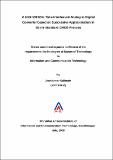Please use this identifier to cite or link to this item:
http://drsr.daiict.ac.in//handle/123456789/242| Title: | 6bit 800 MHz time-interleaved analog to digital converter based on successive approximation in 65 nm standard CMOS process |
| Authors: | Nagchoudhuri, Dipankar Mandal, Sushanta Kumar Salimath, Arunkumar |
| Keywords: | Computer simulation Analog-to-digital converters Metal oxide semiconductors Analog-to-digital converters Catalogs |
| Issue Date: | 2009 |
| Publisher: | Dhirubhai Ambani Institute of Information and Communication Technology |
| Citation: | Salimath, Arunkumar (2009). 6bit 800 MHz time-interleaved analog to digital converter based on successive approximation in 65 nm standard CMOS process. Dhirubhai Ambani Institute of Information and Communication Technology, vii, 55 p. (Acc.No: T00205) |
| Abstract: | High-speed analog-to-digital converters (ADCs) with resolutions of 6 bits find wide application in instrumentation, wireless systems, optical communication. This dissertation presents a 6 bit, 8 channel Time-Interleaved ADC based on Successive Approximation that performs analog processing only by means of open-loop circuits that are fully differential, thereby achieving a high conversion rate. The work involves the design of a charge redistribution hybrid-DAC, low offset comparator, shift register based phase generator and the SAR Logic. Designed in 65 nm Standard CMOS STMicroelectronics Process, across all the PVT corners, the ADC achieves SNDR of 36 dB and SFDR of 43 dBFS at 800 MHz sampling rate with low input frequencies. When the input frequency is at 300 MHz the SNDR drops to 32.6 dB. The converter draws an average power of 13.5 mW from a 1.2 V supply. |
| URI: | http://drsr.daiict.ac.in/handle/123456789/242 |
| Appears in Collections: | M Tech Dissertations |
Files in This Item:
| File | Description | Size | Format | |
|---|---|---|---|---|
| 200711012.pdf Restricted Access | 1.22 MB | Adobe PDF |  View/Open Request a copy |
Items in DSpace are protected by copyright, with all rights reserved, unless otherwise indicated.
